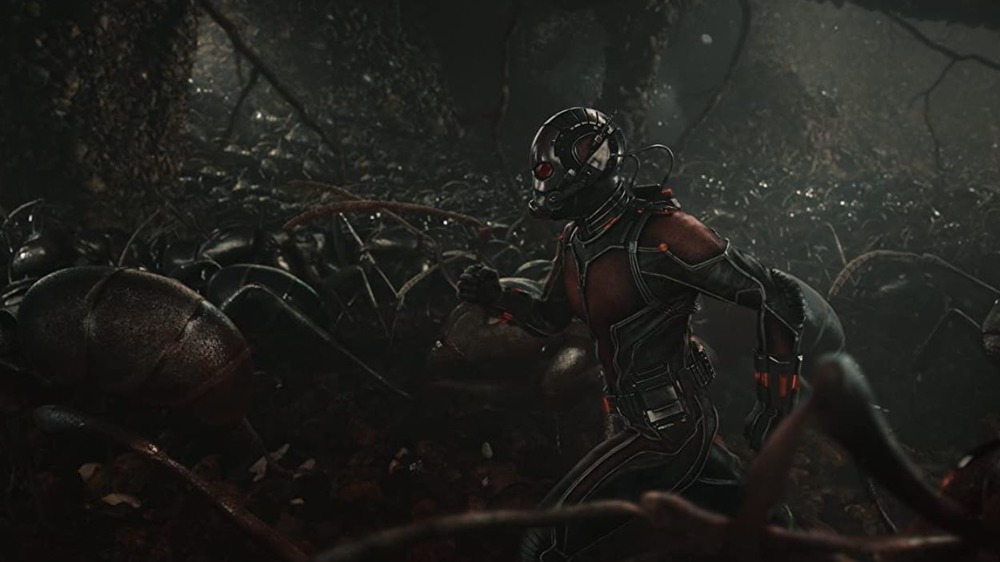Physicist Breaks Down Ant-Man's Pym Particles And Powers
Paul Rudd's Scott Lang debuted in 2015's Ant-Man, a refreshingly light and funny superhero movie that kept its scale suitably small. However, the shrinking-and-expanding, always-wise-cracking hero soon turned out to be one of the more powerful characters in the Marvel Cinematic Universe. By Captain America: Civil War, Ant-Man was actually one of the most dominant fighters in the iconic airport battle, thanks to the surprise reveal of his ability to grow into a powerful Giant-Man.
Ant-Man's visually stunning powers come courtesy of Pym Particles, which are named after the genius scientist and original Ant-Man Dr. Henry Pym, played by Michael Douglas. In the movies, these fictional particles can do a great many things — from shrinking buildings and tanks into lightweight toys to giving people access to the Quantum Realm, which in turn inspired Tony Stark (Robert Downey Jr.) to perfect time travel in Avengers: Endgame.
However, regardless of their many other uses, the Pym Particles are inherently tied to the size-shifting powers of Ant-Man and the Wasp, another shrinking superhero played in the MCU by Evangeline Lilly. We were curious to find out from a physicist's standpoint how these powers might work. To this end, Looper reached out to Dr. Jed Macosko, Ph.D., a Professor of Physics at Wake Forest University and the President of Academic Influence, for insight. Dr. Macosko helpfully broke down what Ant-Man's Pym Particles would be like, and how they would enable the superhero to use his powers.
The nature of Ant-Man's Pym Particles
To find out how the Pym Particles work, one must first understand what they are in the first place.
"Particle physics is tricky business," Dr. Macosko told Looper. "The problem is that some particles are the good old-fashioned ones that make up matter, while others are particles that mediate forces between particles." He went on to note that the Pym Particles appear to be a very special version of the mediating variety: "The particles that Dr. Hank Pym first discovered were of the latter type. The force that they mediate is a special force that changes the configuration of each atom."
A force that can change the configuration of atoms does sound like a pretty cool — and oddly elegant — way to describe the various capabilities of the Pym Particles.
How Ant-Man could use the Pym Particles to shrink
Now that we're armed with the knowledge that Pym Particles could work by tinkering with atom configurations, it's time for the big question — or, rather, the small one. Ant-Man can shrink into an extremely small size, but he retains the strength of a full-size man when he does so. How can Pym Particles change the size of an object or a person, yet throw down with normal-sized people with ease?
According to Dr. Macosko, the process could work by shrinking the empty space within atoms, instead of the physical bits.
"Normally, atoms are largely empty space," he explained. "Electrons whiz in orbits around an unbelievably small nucleus that is orders of magnitude smaller than the diameter of the electron orbitals. But with the force mediated by the Pym Particles, the diameter of the electron orbitals compresses. This causes the entire object that is comprised of these atoms to shrink in size but remain roughly the same mass."
Dr. Macosko did note that the process wouldn't retain all of the person's mass, but even so, it seems like the tiny version of Ant-Man would still pack plenty of punch.
Incidentally, it's also worth noting that this answer isn't all that far off from the pitch the villainous Darren Cross (Corey Stoll) gives in Ant-Man. According to Cross, his version of the Pym Particle is "a particle that could shorten the distance between atoms while increasing density and strength."
How Ant-Man could use the Pym Particles to become Giant-Man
Becoming tiny is one thing, but what about Giant-Man? Surely, if tiny Scott Lang is deceptively strong, the super-sized version should also retain roughly the same mass — which would logically leave him with the offensive potential of a very large yet airy sponge cake. Right?
Not necessarily, according to Dr. Macosko. He told Looper that the growing property of the Pym Particles wouldn't actually be caused by the same particle, but rather another, stranger one that Dr. Pym mistook for the same thing.
"My personal opinion, as a physicist, is that [Dr. Pym] did not actually modify the Pym Particle that he first discovered but used those particles to attract different, even more amazing and tricky particles," he explained. "These particles, which Dr. Pym continued to call Pym Particles not knowing any better, were wormholes to a different dimension. Similar to the now-debunked concept that black holes in one dimension lead to quasars in other dimensions, these subatomic particles channeled energy from another dimension into ours."
If the growing "Pym Particle" actually being a different, stronger particle that channels energy from a strange dimension isn't cool enough, Dr. Macosko then explained precisely how the mass increase could happen: "However, the energy arrived in our universe in the form of mass, according to the famous E = mc2 equation."
Dr. Macosko fully admitted that the relationship between the size-shifting Pym Particles and mass-adding particles isn't really clear — we're talking comic book science, after all. However, he shared with Looper that he thinks it's quite clear the "influx of energy" from the latter would be behind Giant-Man's mass increase.



